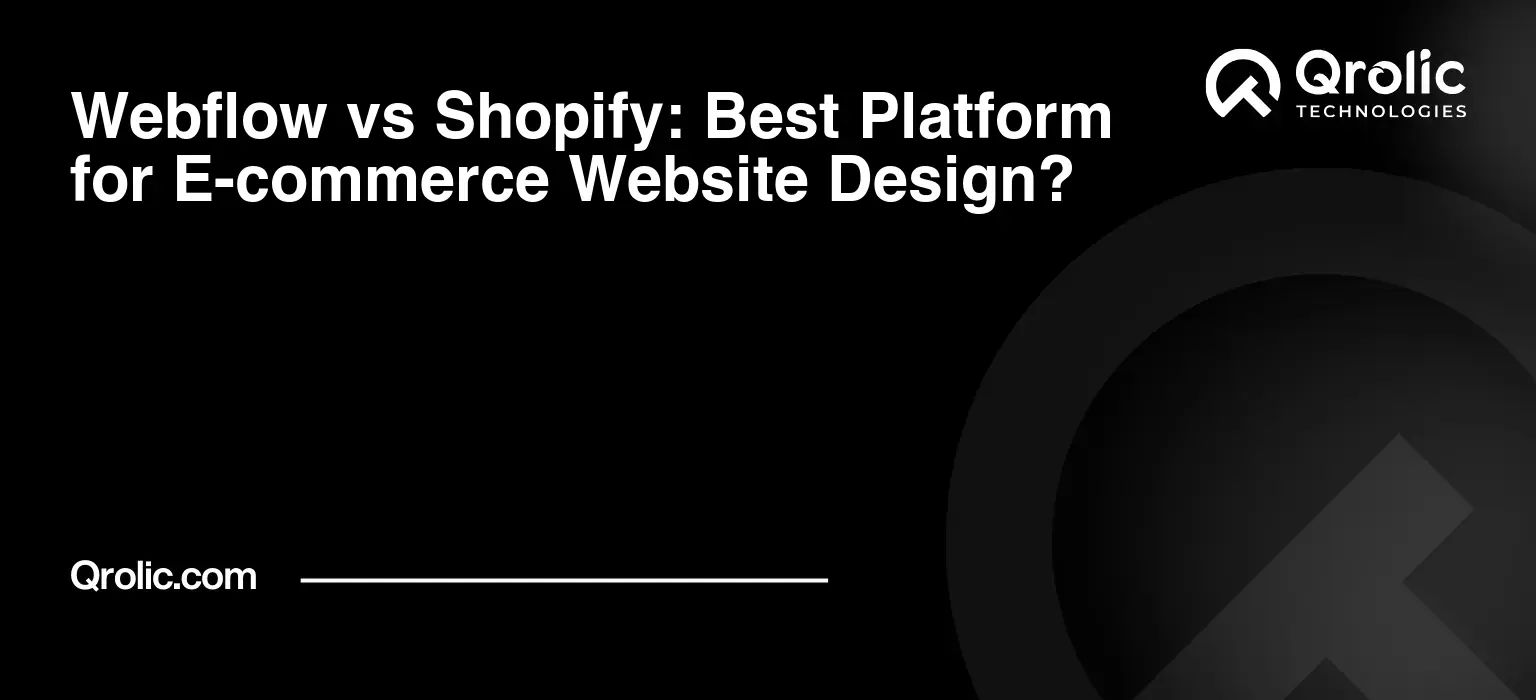Choosing the right platform to build your e-commerce empire is a BIG decision. It’s like picking the perfect foundation for your dream house. You want something sturdy, beautiful, and that fits your unique needs. So, you’re probably asking yourself: Webflow vs Shopify: Which one will help me create the best online store?
This isn’t just about picking a website builder. It’s about choosing a partner for your business journey. One that empowers you to build a brand, connect with customers, and ultimately, drive sales.
In this comprehensive guide, we’ll break down the battle of the e-commerce website builders: Webflow vs Shopify. We’ll dissect their strengths, weaknesses, pricing, and target audiences. We’ll equip you with the knowledge you need to make an informed decision and confidently launch your online store.
Quick Summary:
- Shopify is ideal for easy, comprehensive e-commerce setup.
- Webflow offers unmatched design control for unique stores.
- Choose based on design needs, technical skills, and budget.
- Qrolic Technologies can assist with both platforms.
Table of Contents
- I. Understanding the Core: What Are Webflow and Shopify?
- A. Shopify: The E-commerce Powerhouse
- B. Webflow: The Visual Design Champion
- II. Head-to-Head: Webflow vs Shopify – A Detailed Comparison
- A. Design Flexibility: Unleashing Your Creative Vision
- B. E-commerce Functionality: Selling Power Under the Hood
- C. Ease of Use: How Steep Is the Learning Curve?
- D. SEO (Search Engine Optimization): Getting Found on Google
- E. Pricing: What’s the Cost of Doing Business?
- F. Integrations: Connecting with the Outside World
- G. Scalability: Growing Your Business
- H. Customer Support: Getting Help When You Need It
- III. Webflow E-commerce: A Deeper Dive
- A. Advantages of Using Webflow for E-commerce
- B. Disadvantages of Using Webflow for E-commerce
- C. Examples of Successful Webflow E-commerce Stores
- IV. Shopify: Unveiling the E-commerce Giant
- A. Advantages of Using Shopify for E-commerce
- B. Disadvantages of Using Shopify for E-commerce
- C. Examples of Successful Shopify E-commerce Stores
- V. Choosing the Right Platform: A Strategic Decision
- A. Consider Your Design Needs
- B. Evaluate Your Technical Skills
- C. Assess Your Budget
- D. Define Your E-commerce Needs
- E. Prioritize Your SEO Goals
- VI. The Verdict: Webflow or Shopify?
- VII. Qrolic Technologies: Your Partner in E-commerce Success
- A. How Qrolic Technologies Can Help You:
- B. Why Choose Qrolic Technologies?
- VIII. Conclusion: Empowering Your E-commerce Journey
I. Understanding the Core: What Are Webflow and Shopify?
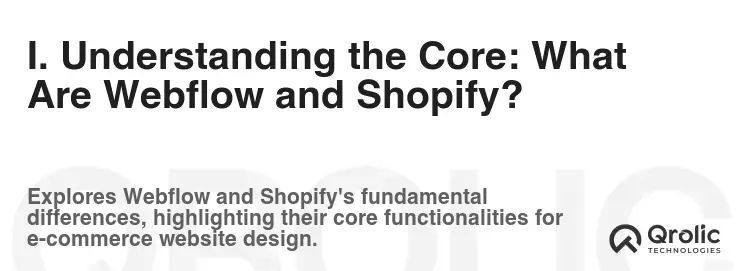
Before diving into the nitty-gritty, let’s establish a foundational understanding of what Webflow and Shopify are all about.
A. Shopify: The E-commerce Powerhouse
Shopify is a dedicated e-commerce platform. Think of it as a complete, all-in-one solution designed specifically for selling online. It handles everything from product listings and payment processing to shipping and customer management.
- What Shopify Does: Shopify simplifies the process of creating and managing an online store, even if you have little to no technical expertise. It provides pre-built themes, integrated payment gateways, and a user-friendly interface.
- Why People Choose Shopify: People choose Shopify for its ease of use, robust e-commerce features, and extensive app store. It’s a great option for those who want to focus on selling rather than getting bogged down in technical details.
- When to Consider Shopify: Consider Shopify when you need a quick and easy way to launch an online store, particularly if you have a large number of products or require advanced e-commerce functionalities.
- How Shopify Works: You select a plan, choose a theme, add your products, configure payment and shipping settings, and start selling. Shopify handles the technical aspects, allowing you to focus on marketing and customer service.
-
Benefits of Using Shopify:
- Ease of Use: Simple interface, even for beginners.
- Comprehensive Features: All the tools you need to run an online store.
- Large App Store: Extends functionality with thousands of apps.
- Scalability: Can handle growing businesses.
- Secure Payment Processing: Integrated payment gateways ensure secure transactions.
B. Webflow: The Visual Design Champion
Webflow, on the other hand, is a visual website builder that allows you to design and build custom websites without writing code. It offers unparalleled design flexibility and control. While not solely dedicated to e-commerce, it has powerful e-commerce capabilities.
- What Webflow Does: Webflow empowers you to create visually stunning and highly customized websites, including online stores. It gives you complete control over the design process, allowing you to bring your creative vision to life.
- Why People Choose Webflow: People choose Webflow for its unmatched design flexibility, ability to create unique and engaging user experiences, and control over every aspect of the website’s design.
- When to Consider Webflow: Consider Webflow when you need a highly customized and visually appealing online store, especially if you have strong design skills or plan to hire a designer.
- How Webflow Works: You build your website using a visual editor, dragging and dropping elements, styling them with CSS-like controls, and defining interactions. Webflow then generates clean, semantic code in the background.
-
Benefits of Using Webflow:
- Unmatched Design Flexibility: Complete control over the look and feel of your website.
- No-Code Development: Build websites without writing code.
- Clean and Semantic Code: Ensures optimal performance and SEO.
- Powerful CMS: Manage your content with ease.
- Advanced Interactions and Animations: Create engaging user experiences.
II. Head-to-Head: Webflow vs Shopify – A Detailed Comparison
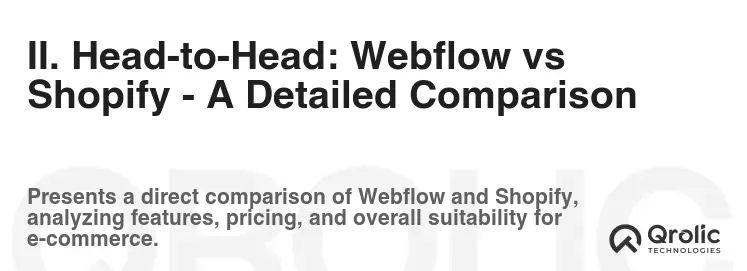
Now that we have a general understanding of each platform, let’s dive into a detailed comparison across various key aspects. This will help you understand their strengths and weaknesses in different areas.
A. Design Flexibility: Unleashing Your Creative Vision
- Shopify: Shopify offers a wide range of pre-designed themes that you can customize to match your brand. While customization options are available, they are limited compared to Webflow. Think of it like choosing a floor plan and making minor adjustments. You’re restricted to the pre-existing structure.
-
Webflow: Webflow provides complete design freedom. You can build your website from scratch, pixel by pixel, giving you ultimate control over every detail. It’s like being an architect, designing the entire house from the ground up. This level of control allows you to create truly unique and visually stunning online stores.
- Winner: Webflow. For sheer design flexibility, Webflow reigns supreme.
B. E-commerce Functionality: Selling Power Under the Hood
- Shopify: Shopify is built for e-commerce. It comes packed with all the essential features you need to run an online store, including product management, inventory tracking, order processing, shipping integrations, and payment gateways. It’s a complete e-commerce solution right out of the box.
-
Webflow: Webflow offers e-commerce functionality, but it’s not as comprehensive as Shopify’s. While you can create product listings, manage orders, and integrate with payment gateways, you might need to rely on third-party integrations for advanced features like abandoned cart recovery or complex shipping calculations.
- Winner: Shopify. Shopify’s dedicated e-commerce focus gives it a clear advantage in terms of built-in features.
C. Ease of Use: How Steep Is the Learning Curve?
- Shopify: Shopify is known for its user-friendly interface. It’s designed to be intuitive and easy to navigate, even for beginners. Setting up your store, adding products, and managing orders is relatively straightforward.
-
Webflow: Webflow has a steeper learning curve. While the visual editor is powerful, it can be overwhelming for those unfamiliar with web design principles. Understanding concepts like CSS, HTML, and responsive design is crucial to effectively use Webflow.
- Winner: Shopify. Shopify’s simplicity and intuitive interface make it the easier platform to learn and use.
D. SEO (Search Engine Optimization): Getting Found on Google
- Shopify: Shopify provides built-in SEO features, such as customizable meta descriptions, title tags, and URL structures. It also integrates with various SEO apps to further optimize your store for search engines.
-
Webflow: Webflow generates clean, semantic code, which is highly favored by search engines. It also allows you to control all aspects of your website’s SEO, including meta descriptions, title tags, URL structures, and image alt text.
- Winner: Webflow. While Shopify offers good SEO features, Webflow’s clean code and granular control give it a slight edge.
E. Pricing: What’s the Cost of Doing Business?
- Shopify: Shopify offers various pricing plans, ranging from basic to advanced, depending on the features you need. Transaction fees apply unless you use Shopify Payments.
-
Webflow: Webflow has separate pricing plans for website hosting and e-commerce functionality. You need a website hosting plan to host your website and an e-commerce plan to sell products online. This can sometimes be more expensive than Shopify, especially if you’re just starting out.
- Winner: It depends. For basic e-commerce functionality, Shopify is often more affordable. However, for highly customized websites with specific design needs, Webflow might be cost-effective in the long run.
F. Integrations: Connecting with the Outside World
- Shopify: Shopify has a vast app store with thousands of apps that integrate with your store to extend its functionality. These apps cover a wide range of categories, including marketing, sales, customer service, and shipping.
-
Webflow: Webflow integrates with various third-party tools and services, but its app ecosystem is not as extensive as Shopify’s. You might need to rely on custom code or Zapier to connect Webflow with certain applications.
- Winner: Shopify. Shopify’s extensive app store provides a wider range of integration options.
G. Scalability: Growing Your Business
- Shopify: Shopify is designed to scale with your business. It can handle large amounts of traffic and transactions without compromising performance.
-
Webflow: Webflow can also handle scaling, but it might require more optimization and configuration as your business grows.
- Winner: Shopify. Shopify is built with scalability in mind, making it a slightly more robust option for rapidly growing businesses.
H. Customer Support: Getting Help When You Need It
- Shopify: Shopify offers 24/7 customer support via phone, email, and live chat.
-
Webflow: Webflow offers customer support via email and a comprehensive knowledge base.
- Winner: Shopify. Shopify’s 24/7 support provides a more readily available resource for immediate assistance.
III. Webflow E-commerce: A Deeper Dive

Let’s take a closer look at Webflow’s e-commerce capabilities to understand its strengths and limitations.
A. Advantages of Using Webflow for E-commerce
- Unparalleled Design Control: Create a truly unique and branded online store that stands out from the competition.
- Clean and Semantic Code: Ensure optimal performance and SEO.
- Advanced Interactions and Animations: Create engaging user experiences that convert visitors into customers.
- Powerful CMS: Easily manage your product listings, content, and blog posts.
- No-Code Development: Build your store without writing code (after the initial learning curve).
B. Disadvantages of Using Webflow for E-commerce
- Steeper Learning Curve: Requires a good understanding of web design principles.
- Less Comprehensive E-commerce Features: Might require third-party integrations for advanced functionality.
- Potentially Higher Costs: Can be more expensive than Shopify, especially if you need to hire a designer.
- Limited App Ecosystem: Fewer integration options compared to Shopify.
C. Examples of Successful Webflow E-commerce Stores
- Mvmt Watches: Known for their minimalist design and engaging user experience.
- Semplice: A portfolio theme built specifically for designers.
- The Roasters Pack: A curated coffee subscription service.
These examples showcase the power of Webflow in creating visually stunning and highly functional e-commerce stores.
IV. Shopify: Unveiling the E-commerce Giant
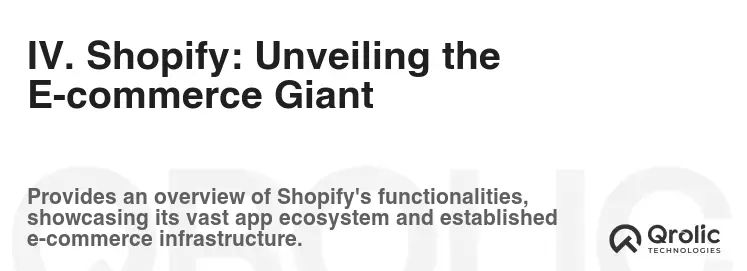
Now, let’s delve into Shopify’s features and benefits to understand why it’s a popular choice for e-commerce businesses.
A. Advantages of Using Shopify for E-commerce
- Ease of Use: Simple interface, even for beginners.
- Comprehensive E-commerce Features: All the tools you need to run an online store.
- Large App Store: Extends functionality with thousands of apps.
- Scalability: Can handle growing businesses.
- Secure Payment Processing: Integrated payment gateways ensure secure transactions.
- 24/7 Customer Support: Always available to help you with any issues.
B. Disadvantages of Using Shopify for E-commerce
- Limited Design Flexibility: Customization options are limited compared to Webflow.
- Transaction Fees: Apply unless you use Shopify Payments.
- Reliance on Apps: Some features require installing third-party apps, which can add to the overall cost.
- Template-Driven Design: Your store might look similar to other Shopify stores.
C. Examples of Successful Shopify E-commerce Stores
- Allbirds: A sustainable footwear brand.
- Gymshark: A popular fitness apparel brand.
- Fashion Nova: A fast-fashion retailer.
These examples demonstrate the versatility of Shopify and its ability to support businesses of all sizes and industries.
V. Choosing the Right Platform: A Strategic Decision
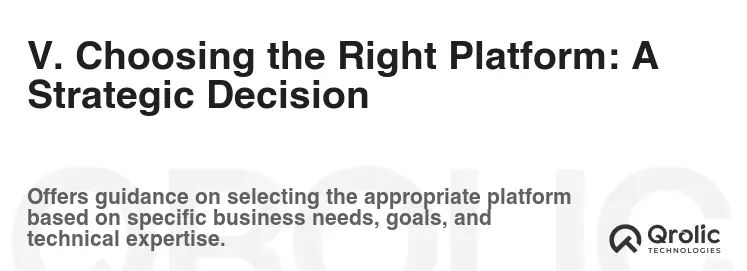
So, which platform is right for you? It depends on your specific needs, skills, and goals. Here’s a framework to help you make the right decision:
A. Consider Your Design Needs
- Do you need a highly customized and visually unique online store? If so, Webflow is the better choice.
- Are you happy with using a pre-designed theme and making minor adjustments? If so, Shopify might be sufficient.
B. Evaluate Your Technical Skills
- Are you comfortable with web design principles and CSS? If so, Webflow might be a good fit.
- Do you prefer a simple and intuitive interface that requires no coding? If so, Shopify is the better option.
C. Assess Your Budget
- Are you willing to invest in design expertise or spend more time learning Webflow?
- Do you prefer a more predictable pricing structure with all-inclusive features?
D. Define Your E-commerce Needs
- Do you need advanced e-commerce features like abandoned cart recovery or complex shipping calculations? If so, Shopify’s extensive app store provides a wider range of options.
- Are your e-commerce needs relatively simple and straightforward?
E. Prioritize Your SEO Goals
- Do you want granular control over every aspect of your website’s SEO? Webflow’s clean code and customization options provide a slight advantage.
- Are you comfortable with the built-in SEO features and integration with SEO apps offered by Shopify?
VI. The Verdict: Webflow or Shopify?
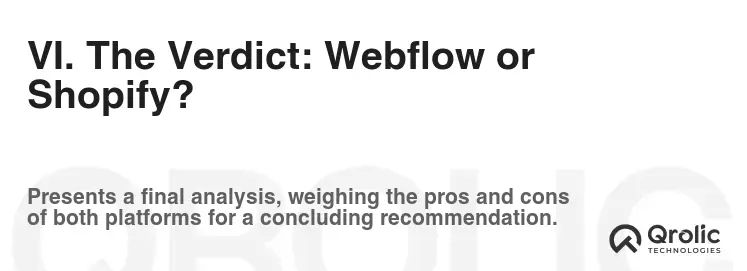
-
Choose Shopify If:
- You need a quick and easy way to launch an online store.
- You have little to no technical expertise.
- You require comprehensive e-commerce features.
- You prefer a simple and intuitive interface.
- You need 24/7 customer support.
-
Choose Webflow If:
- You need a highly customized and visually unique online store.
- You have strong design skills or plan to hire a designer.
- You want complete control over your website’s design and SEO.
- You’re willing to invest time in learning Webflow.
VII. Qrolic Technologies: Your Partner in E-commerce Success

Building a successful e-commerce business requires more than just choosing the right platform. It also requires expertise in design, development, and marketing. That’s where Qrolic Technologies (https://qrolic.com/) comes in.
Qrolic Technologies is a leading digital agency specializing in e-commerce website design and development. We have a team of experienced designers, developers, and marketers who can help you create a stunning and high-performing online store, regardless of whether you choose Webflow or Shopify.
A. How Qrolic Technologies Can Help You:
- Webflow Development: We can design and build custom Webflow e-commerce stores that are visually appealing, user-friendly, and optimized for conversions.
- Shopify Development: We can create custom Shopify themes, develop custom apps, and optimize your store for performance and SEO.
- E-commerce Consulting: We can provide expert guidance on all aspects of e-commerce, from platform selection to marketing strategy.
- SEO Services: We can help you optimize your online store for search engines and drive organic traffic.
- Digital Marketing: We can develop and execute effective digital marketing campaigns to reach your target audience and drive sales.
B. Why Choose Qrolic Technologies?
- Experienced Team: Our team has years of experience in e-commerce website design and development.
- Custom Solutions: We create custom solutions tailored to your specific needs and goals.
- Results-Driven Approach: We are focused on delivering measurable results for our clients.
- Transparent Communication: We keep you informed throughout the entire process.
- Affordable Pricing: We offer competitive pricing without compromising on quality.
Whether you’re just starting out or looking to scale your existing e-commerce business, Qrolic Technologies can help you achieve your goals. Visit our website at https://qrolic.com/ to learn more about our services and how we can help you succeed.
VIII. Conclusion: Empowering Your E-commerce Journey
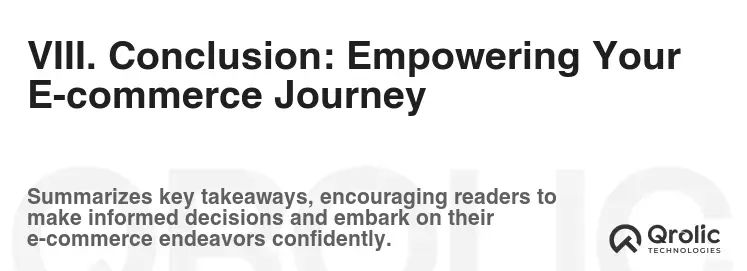
Choosing between Webflow and Shopify is a critical decision that can significantly impact your e-commerce success. By carefully considering your design needs, technical skills, budget, and e-commerce requirements, you can make an informed decision that aligns with your goals.
Remember, both Webflow and Shopify are powerful platforms that can help you create a successful online store. The key is to choose the platform that best suits your unique needs and allows you to bring your vision to life.
And if you need expert assistance along the way, don’t hesitate to reach out to Qrolic Technologies. We’re here to help you build a stunning and high-performing e-commerce store that drives results. Good luck, and happy selling!
